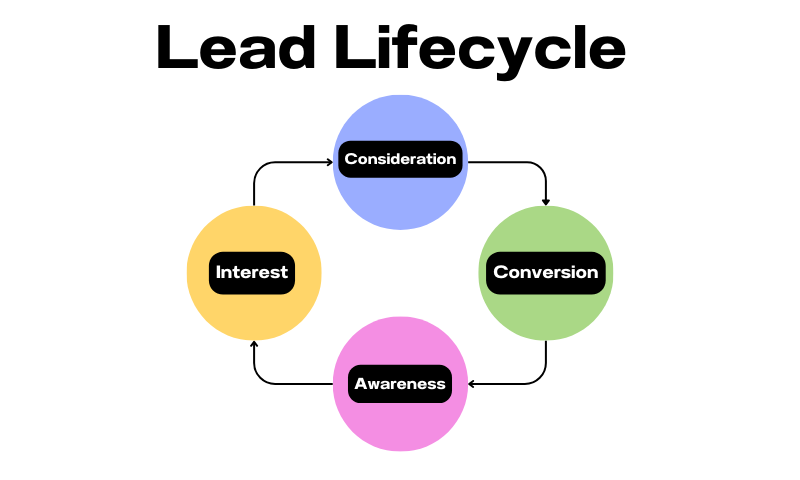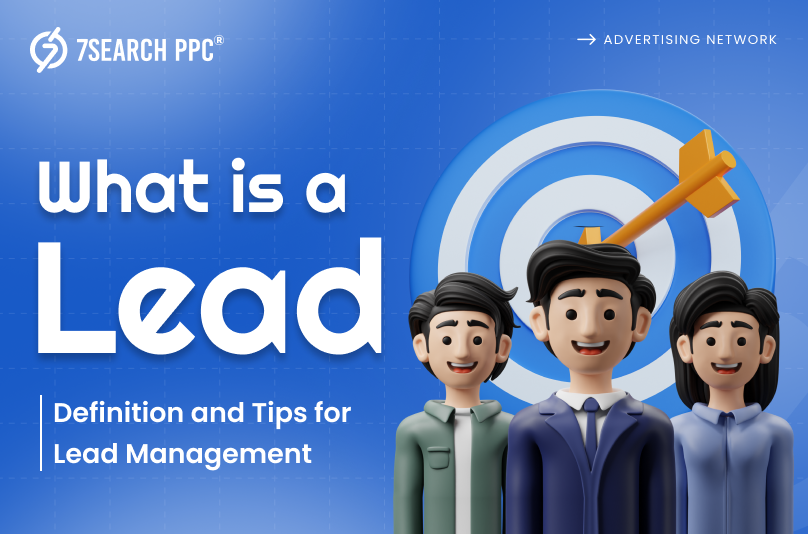Tring! Tring! Your phone rings, and you pick up the call. On the other end, a salesperson wishes you a happy birthday and then introduces you to the latest offers at their car showroom. Let’s take you back for a moment. You recently decided to purchase a car, so you visited the showroom and filled out your details.
Now that you’ve shown interest in buying a car, you’ve become a lead for that company. It is only an example that we have taken. Still, in real life, you might face similar situations where brands use your information to follow up with personalized offers and promotions.
For businesses, lead management is a crucial first step toward achieving their sales goal. Without managing leads, it’s like shooting arrows blindly there’s a chance you might hit the target, but the likelihood of missing is high, leading to significant potential losses.
Now is the time to become a researcher and explore everything about leads and their management. The points covered in this blog will help guide your business in the right direction.
Lead Management: The First Step Toward Brand Growth
We need oxygen to survive, and just like that, brands need one crucial thing to live longer a lead. It is a person or organization that shows interest in your product or service. It’s someone who might become a customer in the future. To manage this well, brands need a good lead management system.
Leads are usually collected through various digital marketing efforts like:
- Website forms
- Social Media
- Virtual Events
Once you have a lead, you can try to engage them by providing more information and answering their questions, with the goal of turning them into a paying customer. They are crucial for growing your business because they represent potential sales opportunities. However, not all leads will turn into sales, as it depends on how effectively you pitch to them.
Can we call them prospects? Let’s find it in the next section.
Leads vs. Prospects: A Clear Comparison
In a previous section, we asked you if we could call leads as prospects. The answer is no because they are at different stages in the sales process. Imagine you are fishing. A lead is like a fish you see swimming in the river. You are not sure if it is the right kind of fish you want to catch, but it’s a potential target.
A prospect is like a fish that you’ve hooked. You have determined that it’s the kind of fish you want, and it’s showing interest in your bait.
In simpler terms, a lead is someone who has shown interest in your offering, often by providing basic contact information. Leads are potential customers, but they might not yet be fully qualified or engaged. A prospect, on the other hand, is a lead who has been further qualified. This means they’ve shown a higher level of interest, fit your target customer profile, and are more likely to make a purchase.
Prospects usually have specific needs and are in the process of considering your solution.
Why does Lead Management Matter?
Keep small brands aside, but a big brand also focuses on a lead management system. Why? Because it matters. Here are some benefits:
Potential For Sales Growth: The right product pitch to the right person is a recipe for success. Leads are people who have shown interest in what your business offers. When you get a lead, you have a chance to turn them into a paying customer. Each one represents a potential sale, which means more revenue for your business. By effectively managing them using a lead management system, you can expand your customer base and increase overall sales, which contributes to business growth.
Targeted Marketing: Leads come with specific information about their interests and needs. This allows you to focus your online marketing efforts on what matters most to them. For example, if a person is interested in a particular product and clicks on your ad, you can send them targeted promotions related to that product. This makes your marketing more relevant and effective as you are addressing the person’s specific desires or problems. This targeted marketing is only possible when you have a good lead management system.
Improved Marketing Efforts: What will you do after getting a lower lead than expected? You will revise your marketing efforts and find the gaps to improve your strategy. When brands focus more on lead management, they gain valuable insights such as:
- The market from where the maximum leads are coming
- The content that holds more attention (more impressions).
- What things should be avoided to prevent wasted efforts and resources in future ad campaigns?
Good Inventory Management: Effective lead management helps you predict future demand more accurately, which is essential for managing your inventory. By analyzing the interests and behaviors of your leads, you can anticipate which products or services are likely to be in demand. This allows you to maintain an optimal inventory level, reducing the risk of overstocking or stockouts. Effective inventory management based on lead analysis ensures that you can meet customer demand while reducing costs.
Competitive Advantage: In a competitive world, having a good lead management system gives you an advantage over your rivals. Leads are your ideal target and are interested in what you offer. By targeting them, you can build strong relationships and enhance your chances of turning them into customers. A consistent flow of leads keeps your sales pipeline active, helping you stay ahead of the competition. This not only boosts your market share but also strengthens your brand’s position as an industry leader.
From Stranger to Customer: A Lead Lifecycle
This lifestyle describes the journey a potential customer takes from being a stranger to turning into a customer. It typically involves several stages:

Stage 1: Awareness
This is the first phase, where ideal customers become familiar with your brand or product through a lead generation campaign. Advertisers use various digital mediums, such as ad networks, social media, or search engine optimization (SEO). The goal is to attract their attention and create interest.
Stage 2: Interest
Purchasing a product or service is totally based on individual interests. This is the second stage, where advertisers show their targeted ads to ideal customers. When the customer shows interest by attempting actions such as downloading whitepapers, signing up for a newsletter, or requesting demos, they are considered a prospect. Following this, the marketing and sales teams assess and qualify these leads as Marketing Qualified Leads (MQL) or Sales Qualified Leads (SQL) to determine which ones are most suitable for pitching offers.
Stage 3: Consideration
In the third stage, potential customers are actively evaluating your product or service alongside competitors. They are likely comparing features, pricing, and benefits to determine the best fit for their needs. To effectively guide customers through this stage, it’s essential to provide them with the information they need to make an informed decision. This might include:
- Customer testimonials and case studies
- Free trials and demos
- Personalized guidance
- Address concerns and doubts
Stage 4: Conversion
The conversion phase is the culmination of the customer journey. It’s when a potential customer decides to make a purchase and becomes an actual customer. To optimize the conversion process, businesses should focus on creating a seamless and frictionless experience. This involves:
- Clear and concise call to action
- Simplified checkout process
- Secure payment options
- Address any last-minute concerns.
Different Types of Leads: Are You Aware of All of Them?
Now, it’s time to check your knowledge to see whether you are aware of the types of leads or not.
Here are some types:
Cold Leads: Cold leads are people who have just found out about your company but don’t know much about your products or services. They have not shown much interest yet, so you need to warm them up by providing information and engaging with them to spark their interest.
Warm Leads: Warm leads are individuals who have expressed some interest in your products or services. They might have interacted with your marketing materials or shown curiosity about what you offer. These leads are more likely to be open to further discussions or offers.
Hot Leads: Hot leads are very interested in your offerings and are actively seeking more information. They are close to making a purchase decision and are highly engaged. These leads are ready for direct sales efforts and often require timely follow-ups to close the sale.
Marketing Qualified Leads (MQL): Marketing Qualified Leads (MQL) are individuals who have been identified by your marketing team as potential customers. They have met certain criteria, like showing interest through interactions or activities. These leads are handed over to the sales team for further nurturing.
Sales Qualified Leads (SQL): Sales Qualified Leads (SQL) are individuals that your sales team has identified as having a high potential to become customers. These leads have demonstrated a strong interest in your product or service through their actions, such as frequent interactions, inquiries, or engagement with sales materials. The sales team further evaluates these leads based on their behavior, ensuring they meet specific criteria that indicate readiness to purchase. SQLs are often prioritized in the sales process because they are seen as the most likely to convert into paying customers.
Key Phases in the Lead Management Process
Above, we understood the lead lifecycle in detail, but if you want to catch them in the right way, you need to sharpen your skill in lead management because it is a systematic approach to identifying, qualifying, and nurturing potential customers. It comprises a set of steps to lead potential customers through the sales process. Here are the key phases:
Generating Leads
Lead generation is the first step, where you collect contact details from potential customers. This is done through your website, social media, and other channels. By offering valuable content or attractive benefits like a free eBook or newsletter, you attract people to share their email addresses, names, and roles. This information is then organized in your CRM to help you manage and follow up on these leads effectively.
Segmenting and Filtering Leads
Not every lead will be a good fit for your business. Lead filtering helps you identify which leads are worth pursuing by assessing their interest and relevance. This involves checking if they match your ideal customer profile. Leads are then segmented into categories, such as “qualified” or “unqualified,” so you can focus your targeting efforts on those most likely to become customers.
Nurturing Leads
Most leads need time to decide before making a purchase. Lead nurturing involves maintaining contact with potential customers through targeted content such as blog posts, emails, and success stories. This builds relationships, keeps your brand in their minds, and guides them toward making a purchase decision.
Scoring Leads
Lead scoring is the next phase of lead management that comes just after nurturing leads, which involves evaluating leads based on their likelihood to make a purchase. By scoring leads based on their interactions and fit with the profile of your ideal customer, you can prioritize which leads should be handled first by your sales team. You don’t need to do anything by yourself because CRM software can handle such tasks.
Distributing Leads
Once leads are scored, they need to be assigned to the right sales representatives. Distribution can be determined by various factors, including location, expertise, and availability. Proper assigning leads ensures that they are handled by the most suitable individuals, increasing the chances of a successful sale.
Converting Leads
The end goal of any business is to convert leads into paying customers. Lead conversion involves guiding qualified leads through the final stages of the buying process and closing the sale. After conversion, continue engaging with the customer to explore future opportunities or repeat purchases.
Tracking Leads
Tracking leads helps evaluate the effectiveness of your lead management process. Monitor metrics such as sales cycle length and conversion rates to obtain insights into what works and what doesn’t. Use feedback from the sales team to refine your strategies and improve your lead management practices.
Proven Tips for Optimizing Lead Management
Don’t be afraid to manage your leads. It’s simple and easy. Here are some insights from experienced marketers that will make your lead management process more effective:
Develop a Strong Lead Generation Plan: To get quality leads, you need a clear strategy. Identify your target audience, choose the right channels (ad networks or social media) to reach them, and create unique but attractive content to catch their interest. Effective lead generation involves understanding what motivates potential customers and launching offers that appeal to their needs.
Build an Easy-to-Use Lead Management System: Your lead management system should be user-friendly and efficient. It should help you track leads, organize their information, and manage interactions without a hassle. Choose a system that integrates well with your existing tools and allows you to automate tasks, saving time and reducing errors.
Implement a Lead Conversion Process: A lead conversion process turns prospects into customers. Create a clear path from initial contact to final sale, including steps like qualifying leads, pitching offerings, and addressing their objections. You must ensure that your process is streamlined and consistent to increase the chances of converting leads into paying customers.
Utilize Real-Time Reporting: Real-time reporting helps you monitor your lead management efforts and make informed decisions. Use tools that provide up-to-date data on lead status, conversion rates, and campaign performance. This allows you to quickly adjust strategies and adjust any issues as they arise.
Create an Engaging Lead Nurturing Campaign: Lead nurturing is about developing and maintaining relationships with potential customers over time. Create a campaign that includes regular, personalized communication such as emails, content offers, and follow-ups. This goal is to keep your leads engaged and interested until they’re ready to make a purchase.
Ensure Prompt Follow-Up On Each Lead: Timely follow-up is very important for converting leads into customers. Reply to inquiries and messages as soon as you can show your potential customers that you appreciate their interest. Prompt follow-up helps build trust and keeps your business top-of-mind for potential customers.
Conclusion
Lead management is the foundation of business growth. It’s like a fishing net that catches potential customers. By understanding different lead types and following the key phases of lead management, businesses can attract, nurture, and convert leads into loyal customers. From generating leads to tracking their progress, a well-structured lead management process ensures that every opportunity is maximized. By implementing effective strategies and utilizing the right tools, businesses can achieve their sales goals and stay ahead of the competition.
Frequently Asked Questions (FAQs)
What is a lead?
A lead is a person or organization that shows interest in your product or service, often by providing their contact details. This interest indicates they might become a customer in the future.
Why is lead management important for businesses?
Lead management is crucial because it helps businesses track, target, and convert leads into paying customers. Without proper management, potential sales opportunities might be lost.
How do businesses generate leads?
Businesses generate leads through various channels like website forms, social media, virtual events, and online ads. These efforts help attract potential customers who may be interested in their products or services.
What is lead scoring, and why is it useful?
It is the process of ranking leads based on their likelihood to make a purchase. It helps businesses prioritize leads, ensuring that the most promising ones receive attention first.
How does a good lead management system benefit a business?
A good lead management system helps businesses organize and track leads, automate tasks, and improve customer engagement. This leads to better conversion rates and more efficient sales processes.

















